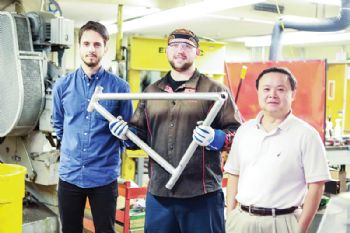
An aluminium alloy developed in the 1940s has long held promise for its use in automotive manufacturing, except for one key obstacle.
Although it is nearly as strong as steel and just one-third the weight, it is almost impossible to weld with the techniquesthat are commonly used to assemble body panels or engine parts; when the alloy is heated during welding, its molecular structure creates an uneven flow of its constituent elements — aluminium, zinc, magnesium and copper — resulting in cracks along the weld.
Now, engineers at the UCLA Samueli School of Engineering in Los Angeles (
www.samueli.ucla.edu) have developed a way to weld the alloy, which is known as AA 7075.
Their solution is based on infusing titanium carbide nanoparticles into AA 7075 welding wires, which are used as the filler material between the pieces being joined. A paper describing this development has been published in Nature Communications.
Using this approach, the researchers produced welded joints with a tensile strength up to 392 megapascals (by comparison, the aluminium alloy AA 6061, which is widely used in aircraft and automotive parts, has a tensile strength of 186 megapascals in welded joints).
Furthermore, the study says that post-welding heat treatment could further increase the strength of AA 7075 joints up to 551 megapascals, which is comparable to steel.
Because it is strong but light, AA 7075 can help to increase a vehicle’s fuel and battery efficiency, so it is often used to form airplane fuselages and wings, where the material is generally joined by bolts or rivets, rather than welded.
The alloy also has been used for products that do not require joining, such as smartphone frames and rock-climbing carabiners.
Xiaochun Li, the study’s principal investig-ator, said: “The new technique is just a simple twist, but it could allow widespread use of this high-strength aluminium alloy in mass-produced products like cars or bicycles.
“Companies could use the processes and equipment they already have to incorporate this super-strong aluminium alloy into their manufacturing processes, and their products could be lighter and more energy-efficient, while still retaining their strength.”
The researchers are already working with a bicycle manufacturer on prototype bike frames that would use the alloy; moreover, the new study suggests that nanoparticle-infused filler wires could also make it easier to join other hard-to-weld metals and metal alloys.